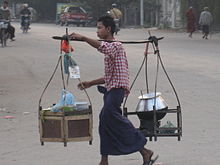Mohinga: Difference between revisions
No edit summary |
No edit summary |
||
| Line 21: | Line 21: | ||
== Availability == |
== Availability == |
||
It is perhaps the most popular breakfast |
It is perhaps the most popular breakfast fish of all, now available as an "all-day breakfast" in many towns and cities. Mohinga is also served with all the trimmings at formal functions and nowadays it is also sold in dry packets as a ready-made powder that is used for making the broth. Street hawkers are the original purveyors of this popular dish doing the rounds through neighbourhoods where they have regular customers. They carry the soup cauldron on a stove on one side of a [[shoulder pole]] and rice vermicelli and other ingredients along with bowls and spoons on the other. It used to be available only early in the morning and at street ''pwè''s or open air stage performances and ''zat pwè''s or itinerant theatres at night. Trishaw peddlers began to appear in the 1960s and some of them set up pavement stalls making mohinga available all day. |
||
<gallery mode=packed> |
<gallery mode=packed> |
||
Revision as of 14:46, 2 December 2016
This article needs additional citations for verification. (February 2013) |

Mohinga (Burmese: မုန့်ဟင်းခါး; MLCTS: mun. hang: hka:, IPA: [mo̰ʊɴhɪ́ɴɡá]) is a rice noodle and fish soup from Myanmar and is an essential part of Burmese cuisine. It is considered by many to be the national dish of Myanmar. It is readily available in most parts of the country. In major cities, street hawkers and roadside stalls sell dozens of dishes of mohinga to the locals and passers-by. Usually eaten for breakfast, today the dish is being consumed more and more throughout the day.
Preparation
There are different varieties of mohinga in various regions of Myanmar. Rakhine mohinga has more fish paste and less soup. Its ingredients depend on their availability. However, the standard dish comes from southern Myanmar, where fresh fish is more readily available. The main ingredients of mohinga are chickpea flour and/or crushed toasted rice, garlic, onions, lemongrass, banana tree stem, ginger, fish paste, fish sauce, and catfish in a rich broth cooked and kept on the boil in a cauldron. It is served with rice vermicelli, dressed and garnished with fish sauce, a squeeze of lime, crisp fried onions, coriander, spring onions, crushed dried chillis, and, as optional extras, crisp fried fritters such as split chickpeas (pè gyaw) (ပဲကြော်), urad dal (baya gyaw) (ဘယာကြော်) or gourd (bu thee gyaw) (ဗူးသီးကြော်) or sliced pieces of Chinese donuts (အီကြာကွေး), as well as boiled egg and fried nga hpè fish cake (ငါးဖယ်ကြော်).
Availability
It is perhaps the most popular breakfast fish of all, now available as an "all-day breakfast" in many towns and cities. Mohinga is also served with all the trimmings at formal functions and nowadays it is also sold in dry packets as a ready-made powder that is used for making the broth. Street hawkers are the original purveyors of this popular dish doing the rounds through neighbourhoods where they have regular customers. They carry the soup cauldron on a stove on one side of a shoulder pole and rice vermicelli and other ingredients along with bowls and spoons on the other. It used to be available only early in the morning and at street pwès or open air stage performances and zat pwès or itinerant theatres at night. Trishaw peddlers began to appear in the 1960s and some of them set up pavement stalls making mohinga available all day.
-
A mohinga trishaw peddler in Mandalay will stop for customers.
-
Mohinga is available all day from pavement stalls such as this in Mandalay.
-
Ready-made packages containing powder to cook mohinga soup is also available.
See also
References
External links
- Mohinga article Archived January 5, 2010, at the Wayback Machine




